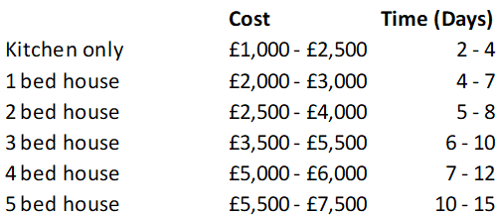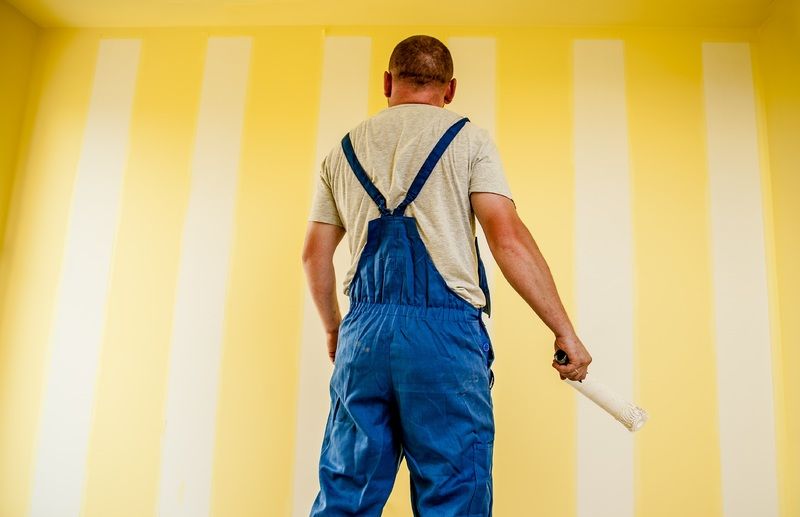Cost of re-wiring a house

All you need to know about rewiring a house but were afraid to ask
We often take the electricity in our homes for granted, providing, light heat and powering our devices that access the internet. We service our cars at regular intervals, but how often should we service our wiring and how much would it cost to have an electrical service or to have our house re-wired.
We show below a summary of illustrative costs for rewiring a house depending on the size of the house

The specific costs will depend on the age of the house, its state of repair and its location, however before deciding to fully rewire your house we recommend that you first get an Electrical Installation Condition Report.
The cost of an Electrical Installation Condition Report (£150-£600)
Before going to the expense of rewiring your house we recommend that you arrange for an Electrical Installation Condition Report (EICR). EICRs were previously known as Periodic Inspection Reports (PIR). This report will be able to give you the best advice as to whether or not you need to fully re-wire your home.
An EICR or Electrical Installation Condition Report can only be written by an experienced qualified electrician or approved contractor. An EICR will highlight any defects in your home’s electrical installation including inadequate short circuit protection, outdated wiring, and faulty connections.
During the EICR assessment the electrician will:
Inspect the consumer unit or fuse board
Inspect of a sample of switches, sockets and other fixtures including light fittings
Checking the polarity of the installation
Test protective devices to ensure they work to protect you from electric shocks
The report will use the following classifications
Code 1 (C1) Danger present. Risk of injury. The electrician may elect to make any C1 hazards safe before leaving your home
Code 2 (C2) Potentially dangerous
Further Investigation (FI) Further investigation is required as soon as possible
Code 3 (C3) Improvement recommended. Further work is not required by is recommended
The cost of the Electrical Installation Condition Report (EICR) will vary by size, age and location of your home, but we provide some indicative costs below:
1 bed flat: £120 - £200
2 bed flat: £150 - £250
3 bed flat: £180 - £300
1-2 bed house: £150 - £350
3-4 bed house: £200 - £400
5 bed and larger: £450 upwards
How frequently should I check my wiring?
The Electrical Safety First charity recommends that homeowners carry out an electrical inspection every 10 years and for tenanted or rental properties every 5 years.
The Electrical Safety Standards in the Private Rented Sector (England) Regulations 2020 require landlords to ensure that the electrical installations and wiring in their rented properties are inspected and tested by a qualified and competent electrician at least every five years.
When do I need to rewire my house?
There are no set guidelines. Many factors could affect the rate of wear and tear including the materials used in the home and how they have been used. The Electrical Safety First Charity recommend a periodic electrical inspection every 10 years for owner-occupied homes and every five years for rented properties.
However, if you notice anything unusual in the home such as burn marks on or around plugs and sockets, or hear buzzing and crackling (called arcing), or if fuses or circuit breakers are regularly tripping then we recommend that you get an electrician round as soon as possible to conduct an Electrical Installation Condition Report (EICR).

Cost of re-wiring your house
If the Electrical Installation Condition Report (EICR) suggests that you rewire your house, we recommend that you go ahead. Rewiring your house is expensive but the risks of fire and electrocution are much worse.
The bad news about the cost rewiring your house
Rewiring is a very messy job. The electrician may have to lift your carpets, take down your skirting boards and cut into the plaster on your walls. Whilst it may not be practical, you may want to temporarily move out of your home whilst the work is being completed.
The work of rewiring your house will come in two parts:
The First Fix installing all the new wiring; and
The Second Fix putting in place all the switches and sockets and testing them all to make sure that they are working safely.
Depending on how much of the plaster on your walls have been damaged in the rewiring process you may want to fact remedial plaster work into the cost of your rewiring project. We discuss the cost of replastering below the house rewiring cost calculator
House rewiring cost calculator
You can use the house rewiring cost calculator below to get a rough idea of how much it will cost to re-wire your home. If you are simply replacing a kitchen we have put illustrative costs of rewiring your kitchen separately. The kitchen is typically the most expensive room to re-wire due to the number of sockets and range of both fixed and portable appliances and lighting in use.

The costs above should only be used as an illustration or guide. Every home is unique and the specific cost of rewiring your house will be determined by its size, location and state of repair.

Cost of replastering a house
There is nothing quite like the look of freshly plastered walls, very smooth to the touch and with very pin-sharp edges, it will give your home a new lease of life.
The cost of the plastering will be determined by the size and scale of the area to be replastered, and whether the walls are to be skimmed or fully replastered.
What is Skimming or skim plastering?
Skimming or skim plastering is a method where instead of removing all the old plaster, a thin layer of finishing plaster is applied over the top of the existing plaster. Skimming involves less work and is, therefore, cheaper than a full replaster. One way to think about skimming is that it is the final stage of creating fully plastered walls
Full replastering
If the essential re-wiring has damaged the walls, you may need to fully replaster the walls rather than skim over the existing plaster. A full replastering requires new plasterboard to be attached to the walls. Once the new boards are in place, the walls will need skimming and finishing to give them the smooth finish.
Newly plastered walls like a drink
Remember not to paint on newly plastered walls until the plaster is dry and remember that plaster is porous. Fresh plaster will soak up an awful lot of paint. If you are painting the walls yourself, we suggest a cheap coat of trade white paint before applying the fancy Farrow & Ball paint.
Plastering cost calculator
The cost of the plastering or skimming the walls will reflect their condition and state of repair. The cost will also be determined by the size of the area to be plastered and where in the country the property is located. However, as a guide, you can use our plastering cost calculator table below.

London prices will be higher